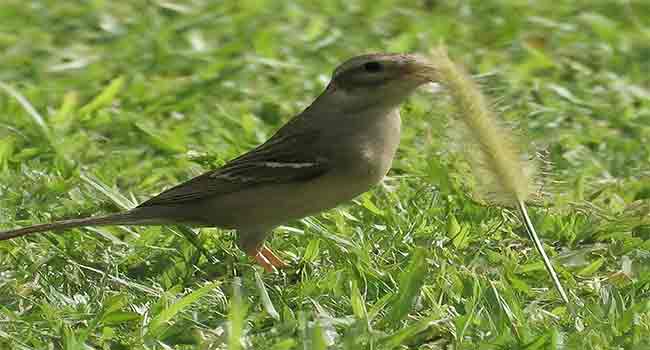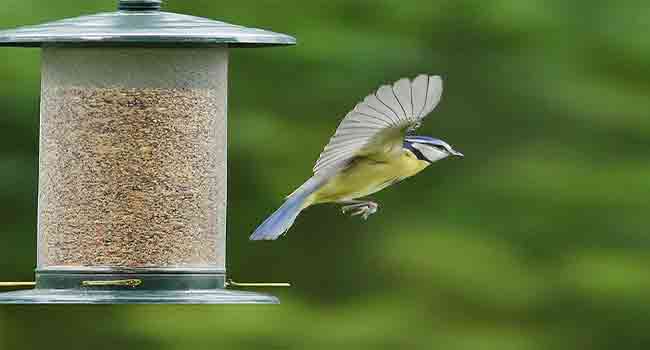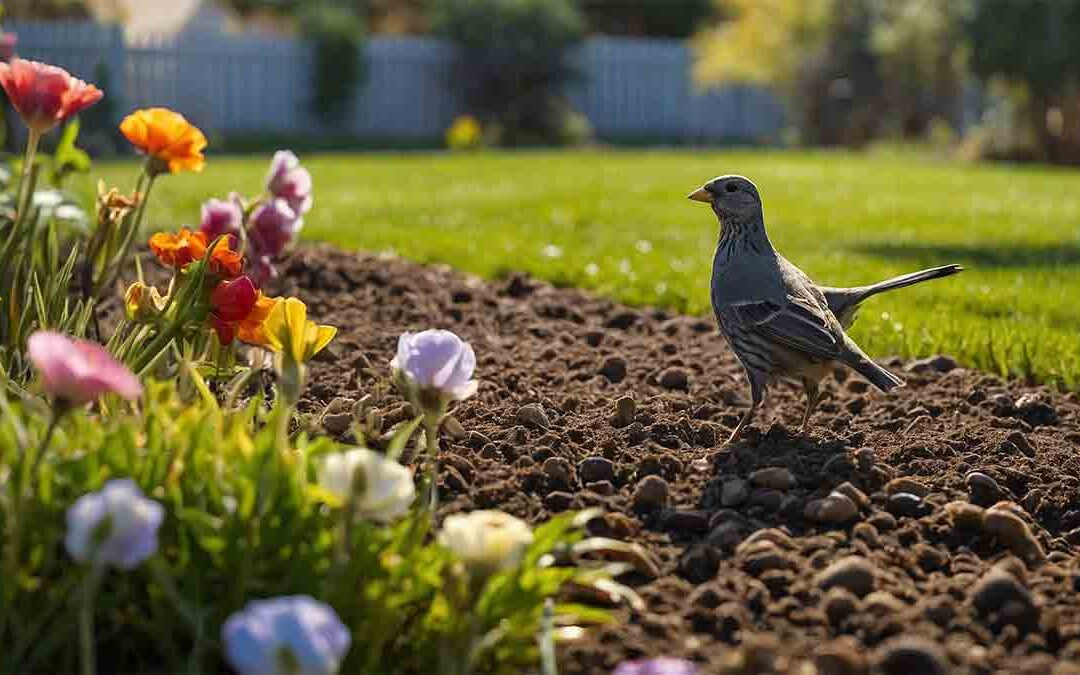Are you tired of watching birds turn your freshly seeded lawn into their personal buffet? It’s a frustrating scenario: You carefully sow grass seed, only to see it vanish overnight, leaving behind patchy, bare spots. These feathered fiends are relentless, gobbling up your hard work and costing you valuable time and money.
But don’t despair! This comprehensive guide is your battle plan against these seed snatchers. We’ll delve into the reasons why birds find grass seed so irresistible, identify the most common culprits, and arm you with 17+ proven and creative strategies to protect your investment.
From budget-friendly DIY hacks to high-tech deterrents, we’ve got you covered. The key to success lies in understanding your enemy and deploying a multi-pronged defense. With the right tactics, you can outsmart even the most persistent birds and finally enjoy a lush, green lawn.
Know Your Enemy: The Birds That Love Your Grass Seed
Why is grass seed so tempting to birds? It’s like a nutritional goldmine for them, packed with energy-rich carbohydrates, proteins, and fats—everything a bird needs to thrive. Newly seeded lawns, with their easily accessible bounty, are especially vulnerable.
But not all birds are created equal when it comes to seed-stealing. Common culprits include:
- House Sparrows: These adaptable little birds are found worldwide and have a particular fondness for grass seed. Their small size and agility allow them to easily maneuver between blades of grass.
- Finches: With their conical beaks designed for cracking seeds, finches are formidable foes for your lawn. House Finches, in particular, are known to cause significant damage to lawns in North America.
- Pigeons and Doves: These larger birds may seem docile, but their appetites are anything but. A flock of pigeons can descend on a lawn and decimate it in a matter of hours. Mourning Doves are another common culprit, especially in areas with abundant bird feeders.
- Blackbirds: While less common in some areas, blackbirds, such as Red-winged Blackbirds and European Starlings, have a voracious appetite for grass seed, especially during nesting season. Their strong beaks allow them to dig up seeds with ease.
- Dark-eyed Juncos: These sparrow-sized birds are ground feeders, making your lawn a prime target. They’re particularly active during spring and fall migration.
Timing is Everything:
Your lawn is most vulnerable during two key periods:
- Spring: Birds are building nests and raising young, requiring a high-energy diet. Your grass seed becomes an easy and abundant source of nourishment. Research from the University of Nebraska-Lincoln has shown that bird damage to lawns is most severe during the spring seeding season.
- Fall: As temperatures drop and natural food sources dwindle, birds begin hoarding food for winter. Your lawn becomes a prime location for stocking their pantries. This is especially true in colder climates where food becomes scarce.
The Need for Speed:
Don’t underestimate the speed and efficiency of these seed bandits. A flock of birds can devour a significant portion of your grass seed in a matter of hours. The longer you wait to take action, the harder it will be to establish a healthy lawn. Delaying bird deterrence measures can result in the need for costly reseeding and additional lawn care efforts. So, act fast!

25+ Proven Methods to Outsmart Seed-Stealing Birds
Your lawn is your canvas, and you deserve to see it flourish, not become a bird feeder. Here’s your arsenal of defense against these feathered foes:
Physical Barriers:
- Netting or mesh: Think of it as a protective blanket for your seedlings. Choose a mesh size small enough to exclude your target birds (1/4-inch mesh is often recommended). Secure it tightly to the ground using stakes or garden staples, ensuring no gaps for sneaky sparrows to exploit. For larger areas, consider using hoops to elevate the netting and prevent it from crushing delicate shoots.
- Fleece: Like a cozy blanket, horticultural fleece provides a lightweight, breathable barrier that allows sunlight and water to reach your seeds while keeping birds at bay. It’s easy to cut and drape over your seeded area, and it can even offer frost protection for early plantings. Secure the edges with rocks or pins to prevent wind uplift.
- Bird-proof fencing: This is your heavy-duty defense, ideal for larger areas or persistent bird problems. Plastic netting is a budget-friendly option, while metal mesh offers greater durability. Ensure your fence is at least 2 feet tall to prevent birds from hopping over and buried a few inches into the ground to stop them from digging underneath.
- Floating row covers: A gentle shield for your seedlings, these lightweight fabrics allow light and water to penetrate while protecting your seeds from birds and harsh weather conditions. They’re easy to install and remove, making them a versatile option for gardens of all sizes. Secure the edges to prevent birds from getting underneath.
- Chicken wire or hardware cloth: These durable and affordable materials are great for DIY bird barriers. Chicken wire has larger openings, suitable for keeping out bigger birds, while hardware cloth offers finer mesh for smaller species. Secure them to the ground with stakes or U-pins. Ensure the barrier is tall enough to prevent birds from reaching over it.
- Straw mulch: A natural and eco-friendly solution, a thin layer of straw (1-2 inches) can camouflage your seeds and make them less appealing to birds. Be sure to apply it loosely enough for the seeds to sprout and avoid using hay, which may contain weed seeds.
Visual Deterrents:
- Scarecrows: Give these classic garden guardians a modern twist. Make them move with the wind by adding dangling limbs or streamers. Attach reflective materials like old CDs or aluminum foil to create flashes of light. For a touch of whimsy, create a scarecrow family or a flock of fake crows to reinforce the message.
Note: Scarecrows may lose effectiveness over time as birds become accustomed to them. - Reflective objects: Birds have a natural aversion to shiny, flashing objects. Hang old CDs from trees, string up holographic tape, or create a whirligig of aluminum pie plates to deter them. For a touch of whimsy, create a mobile of reflective pinwheels that will dazzle and confuse. Move these objects around regularly to maintain their effectiveness.
- Predator decoys: Harness the power of fear! Place realistic decoys of owls, hawks, or even snakes strategically around your lawn. For added realism, move them to different locations every few days to keep birds guessing. Remember, the more realistic the decoy, the better it will work. You can even purchase decoys with sound effects or flashing eyes for added impact.
- Inflatable “scary eye” balloons: These large, colorful balloons with menacing eyes can be surprisingly effective at scaring birds. Hang them from trees or garden stakes, and watch them bob in the breeze, creating an intimidating presence. Change their position occasionally to maintain their effectiveness.
- Mylar balloons or tape: The shiny, reflective surface of Mylar is highly disliked by birds. Hang Mylar balloons from trees or fences, or string up strips of Mylar tape to create a visual barrier. The movement of Mylar in the wind also adds to the deterrent effect.
- Garden spinners: These whimsical decorations can double as bird deterrents. Their spinning motion and reflective surfaces can create unpredictable flashes of light that birds find unsettling.

13. Ultrasonic Devices:
These high-tech gadgets emit high-frequency sounds unpleasant for birds but inaudible to humans. Their effectiveness can vary depending on the brand, bird species, and the layout of your yard (obstacles like trees can disrupt the sound waves). Reputable brands include Bird-X, Hoont, and Cleanrth. A study published in the Journal of Pest Science found that ultrasonic devices could reduce bird damage to crops, but their effectiveness on lawns is still debated.
14. Wind Chimes or Bells:
Transform your backyard into a symphony of bird-repelling sounds! Opt for chimes made of metal with high-pitched tones that birds find particularly annoying. Hang them near the seeded area, allowing the wind to create a constant cacophony that discourages feathered visitors. According to the Cornell Lab of Ornithology, some birds are more sensitive to high-pitched sounds, making chimes a potential deterrent.
15. Recorded Bird Distress Calls:
Harness the power of nature’s alarm system. Play recordings of distressed bird calls, specifically those of the seed-stealing species in your area. For maximum impact, use motion-activated players that surprise birds with sudden blasts of alarming sounds. A study in Crop Protection found that distress calls effectively reduced bird damage in vineyards.
16. Homemade Noisemakers:
Get creative with household items! String up tin cans, tie together old pie plates, or hang aluminum foil strips to create noisy, rattling deterrents. The unpredictable sounds and movement will startle and disorient birds. You can find numerous DIY noisemaker tutorials online for inspiration.
17. Motion-Activated Sprinklers:
Give those pesky birds a surprise shower! Set up sprinklers to activate when motion is detected. The sudden burst of water will startle them and discourage them from returning. As a bonus, your lawn gets a refreshing drink too! This method is particularly effective for larger areas and against birds that frequent your lawn during the day.
Taste Deterrents:
- Commercial Bird Repellents:
These products alter the taste of grass seed, making it unpalatable for birds. Choose from spray-on or granular options, depending on your preference. Some reputable brands include Messina Wildlife, Bonide, and Havahart. Weigh the pros (convenience, effectiveness) against the cons (cost, potential reapplication). The Audubon Society suggests that taste repellents are most effective when used in combination with other deterrents.
- Homemade Chili Pepper Spray:
Spice things up for the birds (not literally, of course)! Mix water with hot chili peppers or cayenne pepper to create a spray that repels birds due to its pungent taste. Apply it to your grass seed and surrounding areas. Important safety note: Always wear gloves and avoid contact with eyes and skin when handling hot peppers.
- Methyl Anthranilate:
This naturally occurring compound, found in grapes, has a pleasant grape scent to humans but tastes repulsive to birds. It’s a safe and effective alternative to harsher chemicals, approved by the EPA for use on food crops. Research by the USDA has shown its effectiveness in deterring various bird species.
- Bitrex:
Dubbed the “most bitter substance in the world,” Bitrex is safe for humans and pets but extremely unpleasant for birds. A few drops mixed into water and sprayed onto your lawn can create a taste barrier. It’s often used in animal repellents and is considered a humane deterrent.
- Garlic or Soap Spray:
These homemade solutions have anecdotal success. While not as potent as commercial repellents, they can be a budget-friendly option for deterring some birds. Garlic spray is made by blending garlic cloves with water, while soap spray is a simple mixture of water and dish soap.
Diversionary Tactics:
- Bird Feeders:
If you can’t beat them, feed them – elsewhere! Set up bird feeders filled with seeds and other treats away from your lawn to lure birds away from your precious grass seed. Place them in a visible location and offer a variety of foods to attract different bird species.
- Water Features:
Birds need water for drinking and bathing, so provide them with a designated oasis away from your lawn. A simple birdbath or a more elaborate fountain will attract them to a different spot. Keep the water clean and fresh to ensure their continued interest. The National Wildlife Federation recommends placing water features in a sunny spot for maximum appeal.
- Plant Decoy Crops:
Use the birds’ own preferences against them! Plant crops that they love, such as sunflowers, millet, or cracked corn, in a designated area away from your lawn. This will give them a more enticing food source to focus on.
- Create a Brush Pile:
By providing a natural habitat for insects, you’re essentially creating a bird buffet away from your lawn. Birds will be drawn to the insects instead of your grass seed.

Matching Your Bird Defense to Your Lawn’s Needs
Not all lawns are created equal, and neither are bird deterrents. Let’s tailor the perfect defense strategy for your unique situation:
-
Your Budget: Bird control doesn’t have to break the bank. If you’re a DIY enthusiast, homemade solutions like chili pepper spray or noisemakers can be highly effective and cost-effective. For those willing to invest a bit more, commercial repellents, ultrasonic devices, or motion-activated sprinklers offer convenient, long-lasting protection.
-
Your Lawn Size: The size of your lawn will dictate which methods are most practical. For small urban gardens, netting, fleece, or reflective deterrents might be sufficient. Larger suburban lawns may benefit from a combination of barriers, decoys, and sound deterrents. For expansive rural properties, consider bird-proof fencing or even professional bird control services.
-
Your Feathered Foes: Different bird species have varying preferences and vulnerabilities. Sparrows might be easily deterred by reflective objects, while pigeons might require a more robust approach like netting or taste repellents. Research the common seed-stealing birds in your area to choose the most effective methods. A study by the University of Nebraska-Lincoln found that visual deterrents were most effective against blackbirds, while taste repellents were more successful with sparrows.
-
Your Local Weather: Environmental conditions can influence the effectiveness of your chosen deterrents. Wind can tangle netting or blow away lighter objects, while rain can wash away taste repellents. Consider your local climate when selecting your methods and plan for adjustments as needed.
Remember: The best defense against seed-stealing birds is often a combination of tactics. Experiment with different methods, observe which ones work best for your specific situation, and don’t be afraid to adapt your strategy as needed. Your lawn will thank you for it!
FAQs: Your Bird & Seed Questions, Answered
- Do birds eat all types of grass seed?
No, some grass varieties are less appealing to birds. Consider planting fescues or perennial ryegrass, which are known to be less attractive to many common seed-eating birds. - When are birds most likely to eat grass seed?
Birds are most active in the spring when they’re building nests and raising young, and in the fall when they’re storing food for winter. However, they may eat grass seed at any time of year if food is scarce. - Is it safe to use bird repellents?
Most commercial bird repellents are safe for humans, pets, and the environment when used as directed. Always read the product label carefully. If you have concerns, consult with a local garden center or wildlife expert. - How long do I need to protect my grass seed?
You should protect your grass seed until it germinates and establishes a good root system, typically within 2-3 weeks. However, you may need to continue using deterrents if birds are persistent, especially during peak feeding times. - Can I use bird netting on an existing lawn?
Yes, but it’s more challenging to install without damaging the existing grass. You might consider using stakes or hoops to elevate the netting or using a lightweight fleece cover instead.
When to Call in the Pros
- If birds continue to decimate your lawn despite your best efforts, it may be time to consult a professional bird control service. They have specialized knowledge and tools to assess the situation and implement effective solutions tailored to your specific needs. This might include habitat modification, trapping, or the use of professional-grade deterrents.
Conclusion How to Keep Birds from Eating Grass Seed
Protecting your grass seed from hungry birds is an ongoing battle, but with the right strategies and a bit of persistence, you can emerge victorious. Remember, the most effective approach often involves a combination of methods tailored to your specific situation.
By understanding bird behavior, implementing a variety of deterrents, and remaining vigilant, you can transform your patchy lawn into the lush, green oasis you’ve always envisioned.

